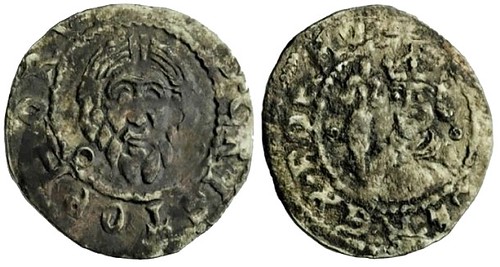
PREV ARTICLE
NEXT ARTICLE
FULL ISSUE
PREV FULL ISSUE
PHOTO SLEUTH SAYLES QUESTIONS COIN FIND REPORT
Wayne Sayles has a great article in the December 9, 2013 Coin Week questioning the significance of an ancient coin discovery reported recently by archeologists in Israel. Here's an except, but be sure to read the full version online.
-Editor

An article posted December 2, 2013 in The Times of Israel caught my attention among many articles of interest in issue #825 of David Meadows’ “Explorator”. The headline “Oldest reference to Bohemian king found in Acre” was bolstered by a coin image purportedly representing a four-year-old archaeological excavation find that has suddenly become a stunning revelation. The coin in question is a medieval denier, a small silver coin of the Crusader era. It bears an image of St. Christopher on the obverse and of a Bohemian king on the reverse (at least as described and illustrated). As the article goes on to explain, this is quite an anomaly both historically and art historically. Unable to properly attribute the coin in-house, the Israel Antiquities Authority called upon experts at Oxford and in Poland for assistance. The expert conclusion was that the coin is a completely new and unexpected combination of types and may be tentatively assigned to the reign of King Premezi Ottokar II (AD 1253-1278). The article does not state whether these expert numismatists examined the coin in hand or whether they merely worked from a copy of the IAA photo that was published along with the article. One might presume in this day and age of high definition photography and electronic transmission that the latter could well have been the case. The article photo is credited to Clara Amit, IAA photography department. The expert commentary quoted in this cited media report deals mainly with general historical background, coin circulation and trade patterns. Having photographed literally tens of thousands of ancient coins in my 50 years as a professional numismatist, and stitched together twice that number of images, it doesn’t take a monumental change in content for me to sense that something may be out of place. It’s a survival instinct of sorts, because collectors tend to get a little miffed (and rightfully so) if the coin they receive in the mail is not the exact coin pictured in a sale. When I saw the IAA image in this article that instinct raised a red flag. Something seemed wrong. Upon closer examination, one will note that the obverse appears to be pierced in the lower left field but there is no corresponding hole nor sign of even partial penetration on the reverse. Copying the reverse image, inverting it, reducing the opacity, and placing it over the obverse image one can see immediately that the obverse and reverse are different sizes. That in itself might simply be a case of the separate obverse and reverse photos not being sized correctly, but rotating the overlay image reveals that the two images are not of the same shape either. One might therefore be inclined to conclude that either the obverse and reverse photos are of two different coins or that there has been some alteration of the images—something that would not be expected from professional archaeologists.
To read the complete article, see:
Ancient Coins: New discovery?
(/www.coinweek.com/ancient-coins/ancient-coins-new-discovery/)
The Numismatic Bibliomania Society is a non-profit organization promoting numismatic literature. See our web site at coinbooks.org. To submit items for publication in The E-Sylum, write to the Editor at this address: whomren@gmail.com To subscribe go to: https://my.binhost.com/lists/listinfo/esylum All Rights Reserved. NBS Home Page Contact the NBS webmaster 
|